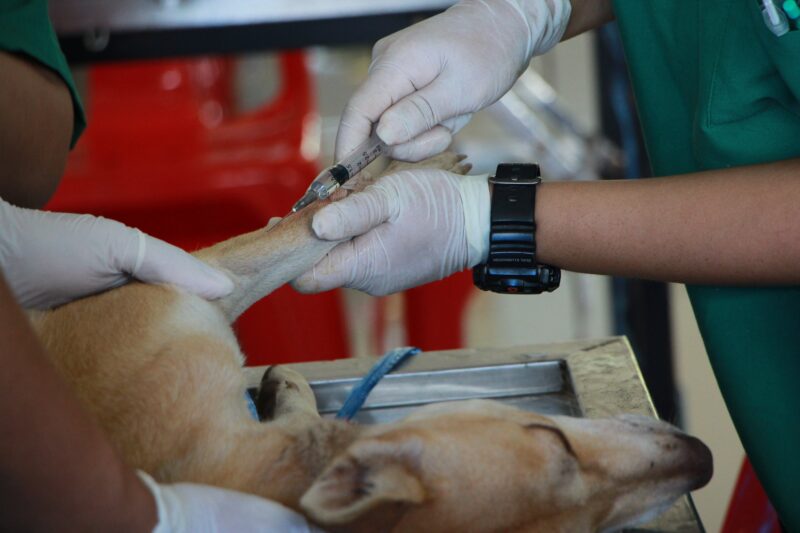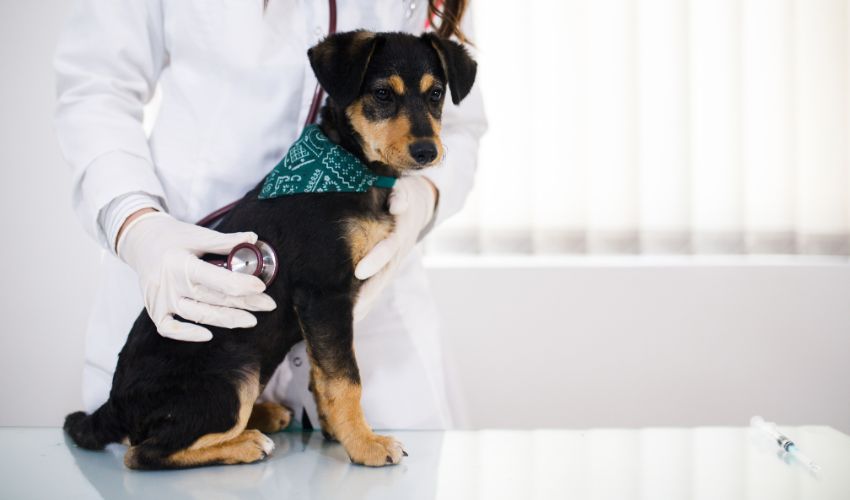Rabies is one of the deadliest zoonotic diseases and dogs are no exception. Getting rabies vaccines for your canine buddy on a regular basis is crucial because there is currently no treatment for the disease. After a dog contracts the virus, it spreads quickly. The development process often takes fewer than ten days, but it can take up a year. Unfortunately, it is usually too late to stop death when the warning signs start to appear. It is dangerous both for you and your furry friend!
You can protect your loyal sidekick from rabies and contribute to their long, happy life by becoming informed about the condition.
Understanding Rabies
Rabies is a viral infection that is spread through saliva. If the saliva of an infected animal comes into contact with a cut, an open wound, or parts of the mouth, eyes, or nose, rabies can also spread through these routes. It is lethal as soon as symptoms appear and damages the nerve system of dogs, including the brain and spinal cord.
It works when the central nervous system (CNS) is attacked by the rabies virus, which then travels from the infection site to the brain via nerves. Animals that contract the infection become paralyzed, eventually affecting their breathing systems and may result in death.
However, one must take note that symptoms can take months to manifest. Generally, your fur baby will show symptoms of the illness two weeks after being introduced. Proper investigation is required, so if you think your dog may have been exposed, get your dog vaccinated and carefully listen to any recommendations from your local public health unit.
Signs of Rabies in Dogs
The standard classification of rabies virus infection has been divided into two main clinical manifestations, namely, the excitatory (“furious”) and the paralytic (“dumb”) forms. However, the presentation of rabies can vary greatly, and not all animals progress through all three clinical stages: prodromal, excitatory, and paralytic. Therefore, this classification system is subjective.
In the prodromal stage, dogs will become agitated, nervous, and afraid, displaying a shift in personality and behavior. Dogs that are friendly can turn violent and vice versa. Within the first two to three days, symptoms appear. Other signs consist of:
- Anxiety
- Fever
- Changes in behavior
- Licking or chewing the bite wound
Dogs going through the furious phase start to exhibit signs of agitation and restlessness as well as a hypersensitivity to light, sound, and touch. They will begin to roam around, attacking people, animals, and inanimate items. These symptoms may last one to seven days. Seizures and disorientation will come next.
Lastly, the paralytic stage, which often appears 2-4 days following the onset of symptoms and might follow the prodromal or furious stage. Mouth foaming may occur as a result of paralysis of the jaw and throat muscles. Additional signs include weakness, coughing, breathing difficulties, respiratory failure, and ultimately, death.
Hydrophobia (fear of water) is a condition that solely affects humans, and is not a sign of canine rabies!
Diagnosis of Rabies in Dogs
According to People’s Dispensary for Sick Animals, there are no tests for rabies in living patients, thus veterinarians must make their diagnosis based on the patient’s travel history, symptoms, and whether the dog was observed being bitten by another animal. The direct fluorescent antibody (dFA) test, which requires the removal and testing of brain tissue samples, is the only method that can provide a definitive diagnosis.

Prevention and Control
Dogs with rabies have no known cure, and if the illness is highly suspected, humane euthanasia is advised.
The only way to protect your loyal companion against rabies is to schedule routine vaccinations for them. Preventing your pets from obtaining this virus in the first place is crucial, as it’s the first line of defense against canine illness. It shields your canine buddy from contracting the rabies virus and shields it from harm if it bites someone.
It is recommended that dogs receive a rabies vaccination between twelve and sixteen weeks of age. For information on the proper intervals between vaccinations and any other queries you may have about canine rabies, get in touch with your veterinarian.
So this question arises: how frequently should dogs get rabies shots? Usually booster vaccines should then be given in 1 year, and every 1-3 years thereafter.
Limiting exposure is another method of preventing rabies in addition to vaccination. Even if your dogs are vaccinated, do not allow them to roam outside the house or yard without a leash and muzzle. Keep your distance from wild animals, whether they are alive or not. It is also important to feed your pet indoors and animal proof your garbage. Don’t forget to notify animal control or appropriate authorities of all stray animals!
Steer clear of wild creatures that appear exceptionally gentle, friendly, or unafraid of people. This particularly pertains to coyotes, foxes, skunks, and raccoons. And even if a bat looks to be dead, NEVER pick it up or handle it.
As a dog owner, you can also prevent yourself from contracting rabies by getting the rabies vaccine shot. If an animal bites you, you will have to get the shot for rabies as soon as possible after the bite attack. This serves as a safety precaution. The vaccine helps your immune system identify the rabies virus and fight against it. But after getting bitten by an animal and the doctor’s test confirming you have contracted rabies, there is no treatment. A very small number of people have survived rabies.












